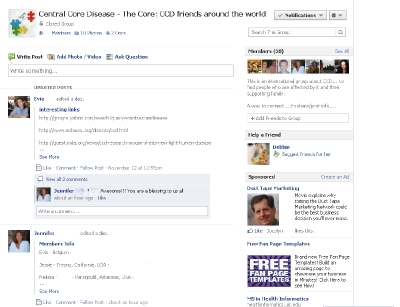![[Image: masthead]](/mhau001/includes/themes/MHAUS_2016/images/masthead/masthead-large.png)
Outside NA: 001-209-417-3722
FOR EMERGENCIES ONLY
Central Core Disease
Central core disease is a disorder that affects muscles used for movement (skeletal muscles). This condition causes muscle weakness that ranges from almost unnoticeable to very severe.
Most people with central core disease experience persistent, mild muscle weakness that does not worsen with time. This weakness affects the muscles near the center of the body (proximal muscles), particularly muscles in the upper legs and hips. Muscle weakness causes affected infants to appear “floppy” and can delay the development of motor skills such as sitting, standing, and walking. In severe cases, affected infants experience profoundly weak muscle tone (hypotonia) and serious or life-threatening breathing problems. Central core disease is also associated with skeletal abnormalities such as abnormal curvature of the spine (scoliosis), hip dislocation, and joint deformities called contractures that restrict the movement of certain joints.
Many people with central core disease also have an increased risk of developing a severe reaction to certain drugs used during surgery and other invasive procedures. This reaction is called malignant hyperthermia. Malignant hyperthermia occurs in response to some anesthetic gases, which are used to block the sensation of pain, and with a particular type of muscle relaxant. If given these drugs, people at risk for malignant hyperthermia may experience muscle rigidity, breakdown of muscle fibers (rhabdomyolysis), a high fever, increased acid levels in the blood and other tissues (acidosis), and a rapid heart rate. The complications of malignant hyperthermia can be life-threatening unless they are treated promptly.

Central Core Disease Facebook Page
Central core disease gets its name from disorganized areas called cores, which are found in the center of muscle fibers in many affected individuals. These abnormal regions can only be seen under a microscope. Although the presence of cores can help doctors diagnose central core disease, it is unclear how they are related to muscle weakness and the other features of this condition.
Source: National Library of Medicine’s Genetics Home Reference
Resources
- Facebook Group: “Central Core Disease – The Core: CCD friends around the world.” This is closed group and you will need to submit apply for invitation.
- Article: “Mutations in the ryanodine receptor gene in central core disease and malignant hyperthermia” by: B M Manning, K A Quane, H Ording, A Urwyler, V Tegazzin, M Lehane, J O’Halloran, E Hartung, L M Giblin, P J Lynch, P Vaughan, K Censier, D Bendixen, G Comi, L Heytens, K Monsieurs, T Fagerlund, W Wolz, J J Heffron, C R Muller, and T V McCarthy – Abstract: Malignant hyperthermia (MH) is a pharmacogenetic disorder of skeletal muscle that is triggered in genetically predisposed individuals by common anesthetics and muscle relaxants. The ryanodine receptor (RYR1) is mutated in a number of MH pedigrees, some members of which also have central core disease (CCD), an inherited myopathy closely associated with MH. Mutation screening of 6 kb of the RYR1 gene has identified four adjacent novel mutations, C6487T, G6488A, G6502A, and C6617T, which result in the amino acid alterations Arg2163Cys, Arg2163His, Val2168Met, and Thr2206Met, respectively. Collectively, these mutations account for 11% of MH cases and identify the gene segment 6400-6700 as a mutation hot spot. Correlation analysis of the in vitro contracture-test data available for pedigrees bearing these and other RYR1 mutations showed an exceptionally good correlation between caffeine threshold and tension values, whereas no correlation was observed between halothane threshold and tension values. This finding has important ramifications for assignment of the MH-susceptible phenotype, in genotyping studies, and indicates that assessment of recombinant individuals on the basis of caffeine response is justified, whereas assessment on the basis of halothane response may be problematic. Interestingly, the data suggest a link between the caffeine threshold and tension values and the MH/CCD phenotype. Full text.